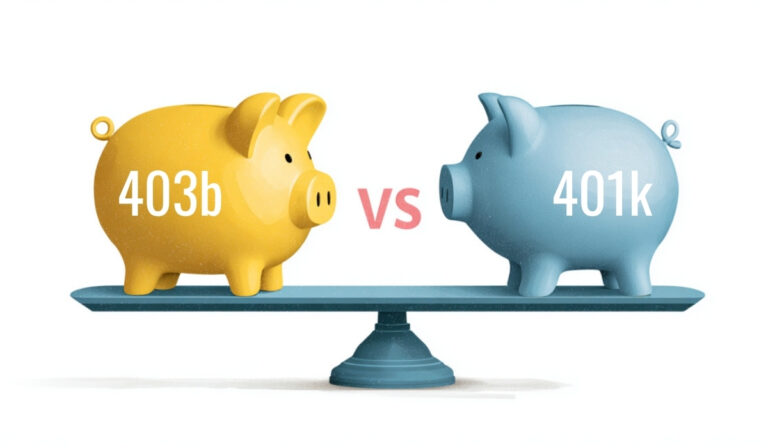Understanding employer-sponsored retirement options is crucial for building long-term financial security. Two common plans, 401(k)s and 403(b)s, help millions of Americans save for their futures. While both offer tax advantages and investment growth, they cater to distinct workplace environments.
The 401(k) plan, established in 1978, serves employees at for-profit companies. Over 70 million workers rely on these accounts today. The 403(b), created in 1958, supports staff at public schools, non-profits, and religious organizations. These plans now hold $1.3 trillion in combined assets.
Your employer type usually determines which plan you access. For-profit businesses rarely offer 403(b)s, while non-profits typically don’t provide 401(k)s. Workers switching industries during their careers may encounter both systems. Knowing their structures helps maximize contributions and benefits.
Key Takeaways
- 401(k) plans serve for-profit company employees
- 403(b) plans support non-profit and public sector workers
- Employer type dictates available retirement account options
- Both plans offer tax advantages and long-term growth potential
- Career changes may require adapting to different retirement systems
Overview of Employer-Sponsored Retirement Plans

Nearly 70% of private sector workers access retirement plans through their jobs, making these benefits a critical economic safety net. Employer-sponsored programs help workers build financial stability through automatic payroll deductions and professional investment management.
These plans often determine whether employees can maintain their lifestyle after leaving the workforce.
Importance of Retirement Savings
Over 23% of Americans aged 66+ live below the poverty line – a stark reminder of retirement planning gaps. Consistent contributions to employer plans help combat this crisis. Financial experts urge workers to allocate 15% of annual income to retirement accounts, though many start with smaller percentages.
General Features and Tax Advantages
Most employer-sponsored plans offer immediate tax benefits. Pre-tax contributions lower current taxable income while investments grow tax-deferred. Roth options provide tax-free withdrawals in retirement for those who qualify.
These plans work alongside Social Security and personal savings to create layered financial protection. Employers often enhance participation through automatic enrollment features and matching contributions. Workers who maximize these benefits typically achieve better long-term outcomes than those relying solely on individual savings.
Understanding the Basics: What is a 403b Plan?
Public school teachers and non-profit workers often encounter specialized retirement savings options. The 403(b) plan—sometimes casually called a 403b—serves employees at tax-exempt organizations.
This retirement plan helps educators, healthcare professionals, and charity workers build financial security through systematic savings.
Definition and Eligibility Criteria
Only specific employers offer 403(b) plans. Qualified organizations include public schools, religious groups, and non-profits with 501(c)(3) status. Ministers, tribal education staff, and certain medical researchers may also participate based on their employment contracts.
Eligibility depends entirely on workplace classification rather than income levels or job titles. Employees automatically qualify if their organization sponsors the plan. This structure ensures retirement access for workers in sectors with traditionally lower compensation.
Key Features and Benefits
These plans allow pre-tax contributions that reduce current taxable income. Investments grow tax-deferred until withdrawal during retirement. Many 403(b)s provide Roth options for tax-free qualified distributions.
Participants choose investments from approved mutual funds or annuities. Contribution limits mirror 401(k) thresholds, with catch-up options for workers over 50. Employers sometimes match contributions, though this varies by organization.
With $1.3 trillion in assets, 403(b) plans demonstrate their importance in public sector retirement planning. Their tax advantages and payroll deduction systems make consistent saving easier for mission-driven professionals.
Understanding the Basics: What is a 401k Plan?
Corporate workers across America rely on a retirement savings tool born from tax code section 401(k). Designed by benefits consultant Ted Benna in 1980, this system now serves 42% of U.S. workers.
Employees fund these accounts through automatic paycheck deductions, building nest eggs with tax advantages.
Plan Overview and Structure
For-profit companies provide 401(k) plans to help staff save systematically. Workers choose contribution percentages from their salaries, often receiving employer matches.
“The beauty lies in its simplicity,” notes a Fidelity Investments report. “Automatic deductions make consistent saving effortless.”
Tax Advantages and Investment Flexibility
Participants select between traditional pre-tax contributions or Roth after-tax payments. Investments grow tax-deferred until withdrawal age. Most plans provide diverse choices:
| Investment Type | Risk Level | Common Providers |
|---|---|---|
| Target-Date Funds | Moderate | Vanguard, Fidelity |
| Stock ETFs | High | BlackRock, State Street |
| Bond Mutual Funds | Low | PIMCO, T. Rowe Price |
Over 90% of plans now include environmental and social investment options. This flexibility helps workers align portfolios with personal values while pursuing growth.
403b vs 401k: Core Differences in Eligibility and Contributions

Workers saving for retirement face distinct rules based on their employer’s plan type. While contribution limits appear identical at first glance, special provisions create meaningful differences in long-term savings potential.
Annual Savings Caps and Acceleration Options
Both plans allow workers under 50 to contribute $23,500 in 2024, decreasing to $23,000 in 2025. Employees aged 50+ get $7,500 in standard catch-up contributions. Those aged 60-63 can save an extra $11,250 if their plan permits.
| Feature | 403(b) | 401(k) |
|---|---|---|
| 15-Year Service Bonus | Up to $3,000/year | Not Available |
| Lifetime Limit | $15,000 | N/A |
| Age 60-63 Boost | Plan-dependent | Plan-dependent |
Withdrawal Requirements and Tax Considerations
Mandatory withdrawals generally start at age 73. Some 403(b) plans let participants delay until 75. These required minimum distributions ensure tax-deferred savings eventually enter the tax system.
Workers should consult detailed comparisons when changing jobs between sectors. Understanding these rules helps maximize savings while avoiding IRS penalties.
Exploring Investment Options and Employer Matching

Retirement savers’ account growth depends heavily on two factors: available investment vehicles and employer-sponsored incentives. These elements determine how effectively contributions compound over time and whether workers capture full financial benefits from their employment.
Available Investment Choices
Workers encounter stark differences in portfolio-building tools between retirement plans. Corporate retirement accounts typically offer stocks, bonds, ETFs, and target-date funds. Public sector plans operate under stricter federal guidelines limiting choices to annuities and mutual funds.
| Plan Type | Common Investments | Diversification Options |
|---|---|---|
| 401(k) | Stocks, ETFs, Bonds | High |
| 403(b) | Annuities, Mutual Funds | Moderate |
Employer Match and Its Impact on Savings
Corporate employees often receive matching funds – essentially free money boosting retirement savings. A typical program matches 50% of contributions up to 6% of salary. For someone earning $60,000, this adds $1,800 annually when maximizing the match.
Non-profit workers face different realities. Only 56% of 403(b) plans offer employer matches compared to 85% of 401(k)s. This disparity highlights why workers should review their plan’s matching structure during benefits enrollment.
Financial advisors stress prioritizing employer matches above other investments. “Failing to claim full matching dollars equals rejecting a salary increase,” notes a Vanguard retirement specialist. This immediate return often outperforms market gains.
Catch-Up Contributions and Additional Benefit Opportunities

Retirement savers approaching their later working years gain special opportunities to boost savings. These provisions help workers compensate for delayed saving or career changes. Both plan types offer tools to accelerate nest egg growth as retirement nears.
Age-Based Catch-Up Contributions
Workers aged 50+ can add $7,500 annually beyond standard limits. Recent updates created an extra $11,250 allowance for those aged 60-63. This “double catch-up” helps late starters maximize savings in their peak earning years.
| Age Group | Additional Contribution | Plan Availability |
|---|---|---|
| 50+ | $7,500 | All plans |
| 60-63 | $11,250 | If plan allows |
Exclusive Catch-Up Options for Long-Term Employees
Public sector workers get unique benefits after 15+ years of service. Eligible 403(b) participants can contribute up to $3,000 extra annually. The lifetime limit for this provision is $15,000.
A teacher with 20 years at the same school could calculate their bonus as:
$5,000 × 20 years = $100,000 total potential
Minus previous deferrals = Available catch-up space
Financial advisor Rachel Carter notes: “These provisions reward loyalty in fields where salaries often lag private sector pay.” Workers should consult plan documents to confirm eligibility and limits.
Assessing Costs and Fees for Optimal Retirement Savings

Retirement plan fees act as silent partners in every saver’s portfolio, quietly shaping long-term growth. Workers often overlook these expenses until reviewing annual statements. A 1% difference in fees can reduce retirement savings by 28% over 35 years, according to Department of Labor projections.
Administrative and Management Costs
Corporate retirement accounts typically carry higher administrative fees. These cover record-keeping, compliance, and customer service. For-profit providers charge 0.5%-1.25% annually for these services. Non-profit sector plans often cost 0.3%-0.75% due to tax-exempt status and streamlined operations.
| Fee Type | 401(k) | 403(b) |
|---|---|---|
| Administrative | 0.85% avg | 0.55% avg |
| Investment | 0.40% avg | 0.65% avg |
| Service Charges | $25/year | $15/year |
Evaluating Cost Versus Benefit Trade-offs
Mutual funds in non-profit plans often carry higher expense ratios than corporate account options. “Low fees mean nothing if investment choices don’t match your goals,” advises financial planner Lisa Greenfield. Workers should compare expense ratios in their plan’s fee disclosure documents.
Consider both immediate costs and long-term growth potential. A retirement account with slightly higher fees might offer better-performing investments. Balance employer matches against expense ratios – a 3% match usually outweighs a 1% fee difference.
Tips for Choosing the Right Plan for Your Retirement

Selecting the ideal retirement strategy requires matching personal financial goals with workplace offerings. Workers should evaluate their career trajectory, risk tolerance, and long-term objectives when comparing plan features.
Aligning Retirement Goals with Plan Features
Start by estimating desired retirement age and lifestyle needs. Compare investment options across available plans, focusing on diversification potential and historical performance. Tax benefits and withdrawal rules significantly impact long-term growth.
Public sector employees might prioritize stable annuity choices, while corporate workers could benefit from broader stock market access. Review expense ratios and administrative fees to minimize cost drag on returns.
Maximizing Employer Benefits and Matching Contributions
Always contribute enough to claim full employer match funds – this free money accelerates retirement savings. If your workplace offers a 50% match up to 6% salary, contribute at least 6% to double part of your investment immediately.
Annual reviews help ensure alignment with changing life circumstances. Consult a financial advisor to optimize contributions across multiple accounts while staying within IRS limits.

